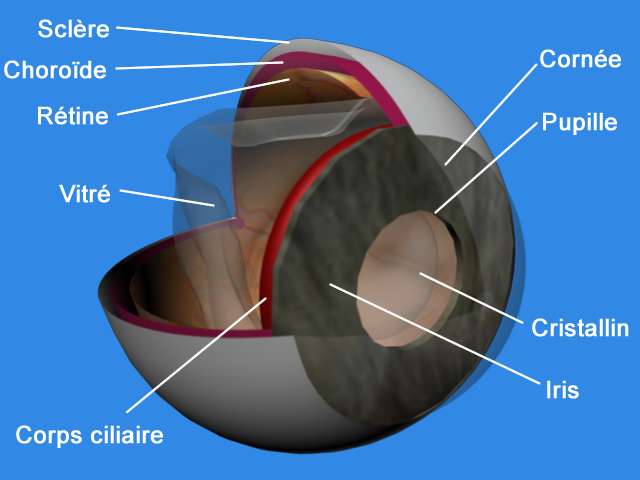Eye anatomy
 by
Mamisoa Andriantafika
by
Mamisoa Andriantafika
The eye is anatomically divided between the anterior segment in front of the cristalline lens, and the posterior segment back.
The anterior segment
Main items in the anterior segment are the cornea, the conjunctiva, the sclera, the iris and the cristalline lens.
Cornea is a transparent external layer where you can see through the color of the iris and the pupil in the center. Different layers of the cornea are similar to the ones in your skin. The very superficial layer is very fragile and innervated, the epithelium. As for the skin, a tear would expose the innervation, as it could happen with a superficial traumatism. Resulting pain is therefore very intense.
Conjunctiva is a white flaccid mucous layer that cover the superficial layer of the eye, the sclera. It contains many glandular cells responsible for the regulation of the tear film. It is also a frequent source of inflammation called conjunctivitis.
Cornea is the front transparent layer of the eye where the color of the iris and the pupil are visible.
When the natural lens gets cloudy, it is called cataract.
Iris est a colored muscle, with a round central aperture, the pupil. Its colour depends on its superficial layer. Depending on its thickness and texture absorbing light, its colour is different from one to another.
Cristalline lens is just behind the iris. It is usually transparent. Its curvature can change to permit accommodation, the process that makes you focus from far to near vision. When it gets more rigid, accomodation is more difficult, it is then called presbyopia. When it gets cloudy, it is called cataract.
The posterior segment

Principal items of the posterior segment are: the vitreous body, the ciliary body, the retina, the choroide, the sclera and the optic nerve. Retina, choroid and sclera form the wall of the eye.
Vitreous body is a jelly substance filling the posterior part of the eye, behind the eye. It’s an embryonic residue. With age, it dehydrates and looses its volume. It can forms some small filaments and mobile condensations called floaters.
Ciliary body is circular behind the iris, continuous to the choroide. The front part project filaments that hold the lens, called zonules. The back part is formed by folds called ciliary processes. They secrete aqueous humor that regulates the tonus of the eye, measured by the intraocular pressure. If it is elevated, it can lead to glaucoma.
Retina is the photographic film of the eye. The area directly in the visual axis is called the macula. The very central and sensible part of the macula is called the fovea. Common disease that affect the macula is called Age Related Macular Degenerescence or ARMD.
High ocular pressure can lead to glaucoma.
Choroide is the vascular layer under the retina. The front part is the ciliary body. Retina and choroide are intimately linked. If an hemmorage occurs, retina will soaked and vision will be severed.
Sclera is the outer layer of the eye. Its function is mainly structural. It give its rigidity to the eye. It is therefore a good recipient for therapeutic implants or slow released drugs.
Optic nerve is composed of optic fibers linking the eye to the brain. It is covered by an outer layer of myeline that greatly increases the speed of the visual influx. Common demyelinating disease is multiple sclerosis, although glaucoma is the most frequent affection impairing the optic nerve.